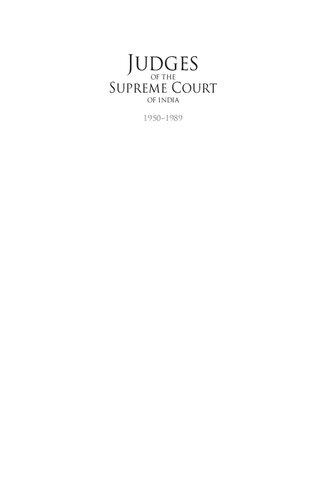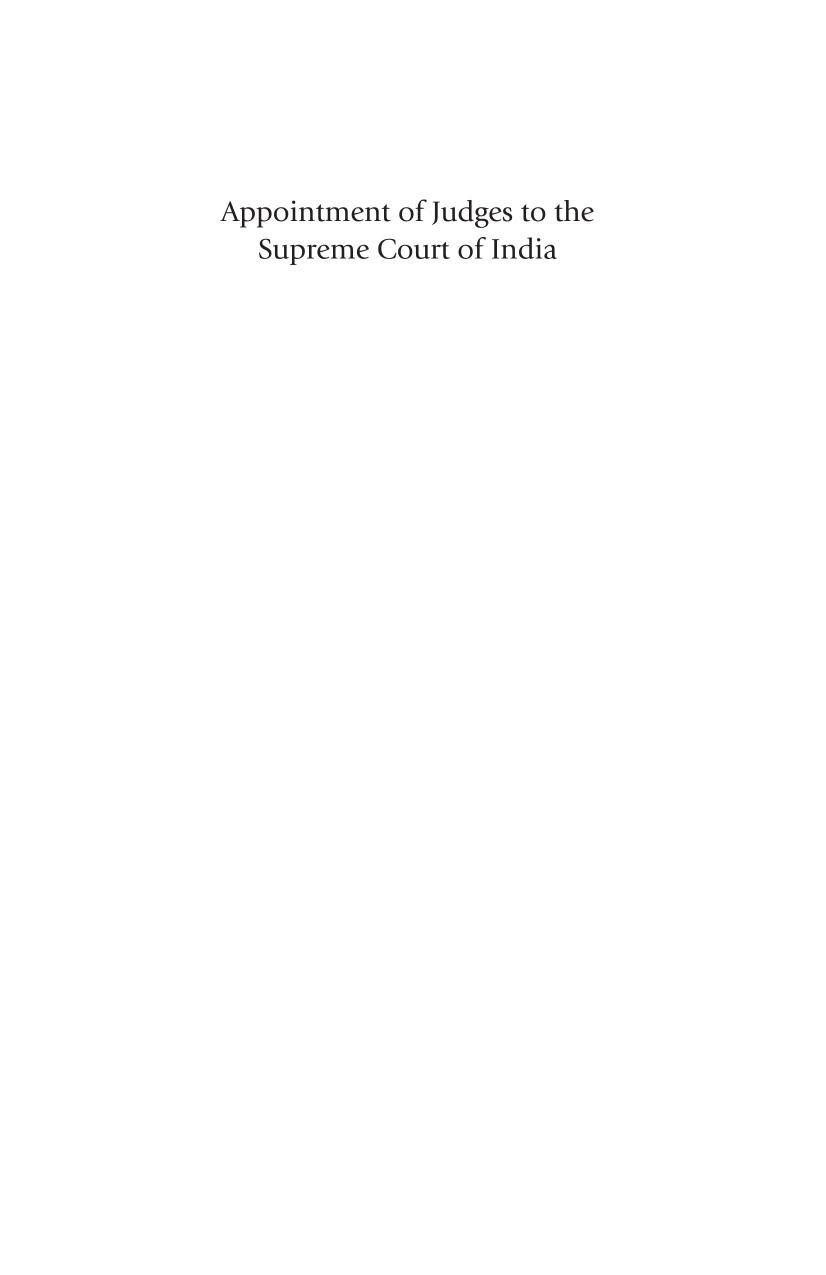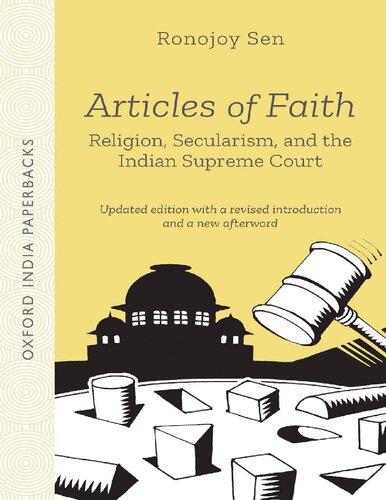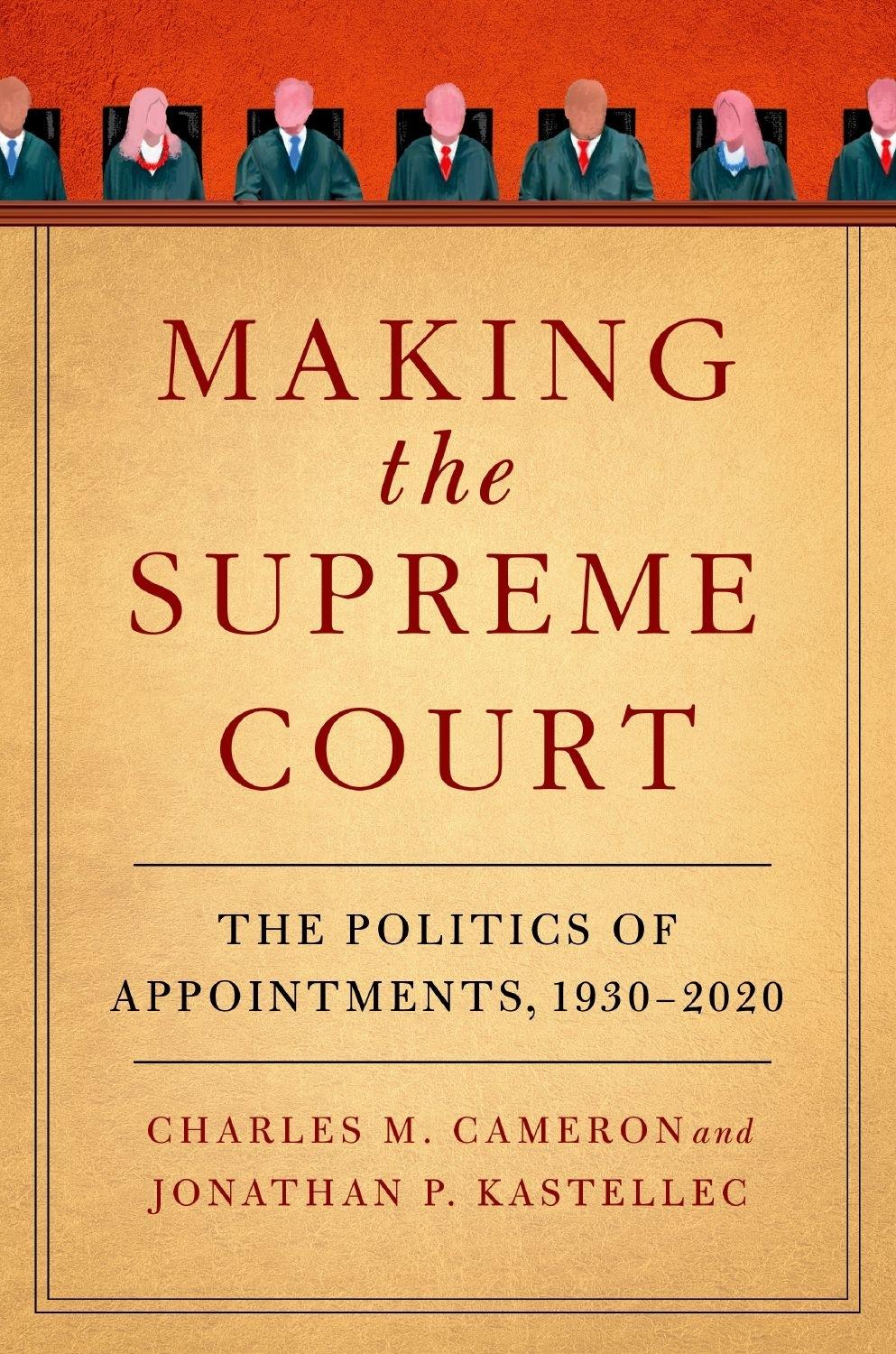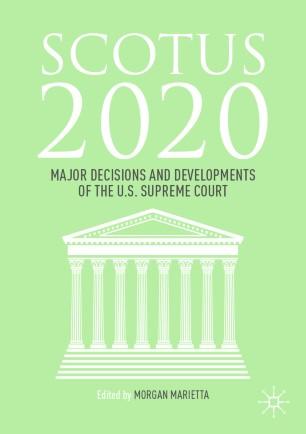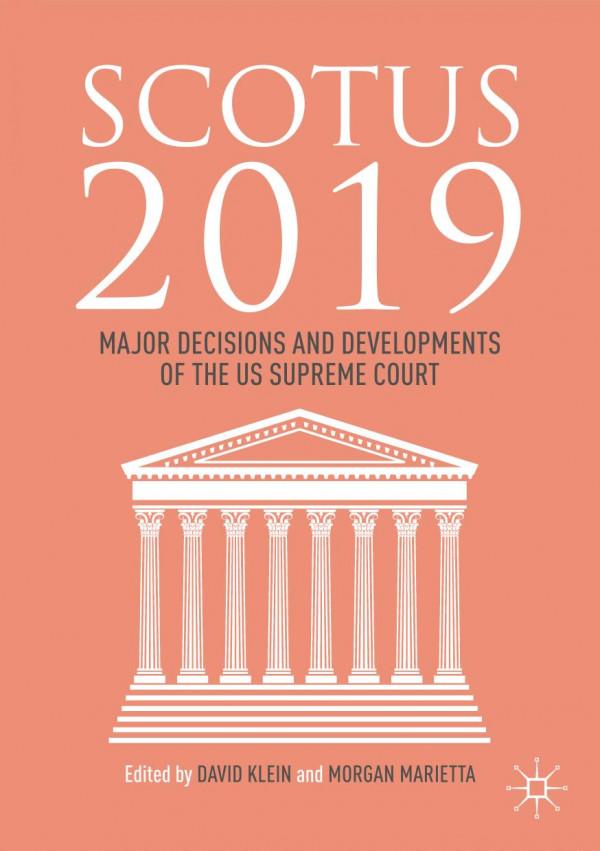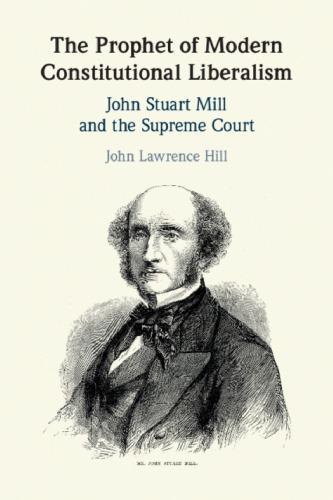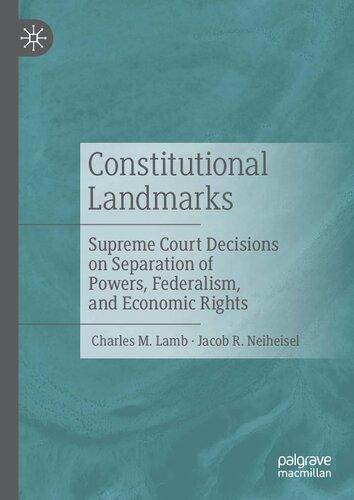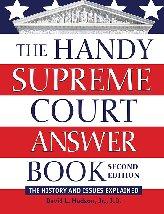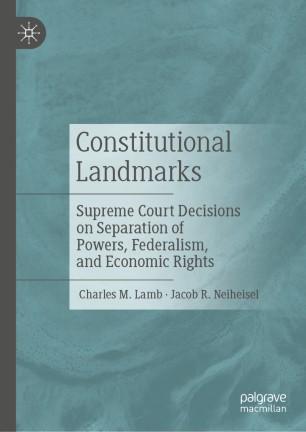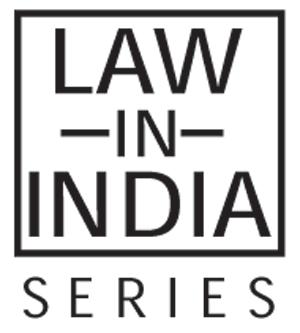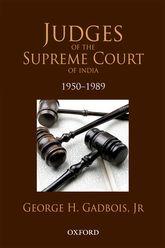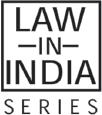Judges of the Supreme Court of India: 1950-89 George H. Gadbois
Visit to download the full and correct content document: https://ebookmass.com/product/judges-of-the-supreme-court-of-india-1950-89-george -h-gadbois/
More products digital (pdf, epub, mobi) instant download maybe you interests ...
Appointment of Judges to the Supreme Court of India: Transparency, Accountability, and Independence Arghya Sengupta And Ritwika Sharma
https://ebookmass.com/product/appointment-of-judges-to-thesupreme-court-of-india-transparency-accountability-andindependence-arghya-sengupta-and-ritwika-sharma/
Articles of Faith: Religion, Secularism, and the Indian Supreme Court Ronojoy Sen
https://ebookmass.com/product/articles-of-faith-religionsecularism-and-the-indian-supreme-court-ronojoy-sen/
Making the Supreme Court: The Politics of Appointments, 1930-2020 Charles M. Cameron & Jonathan P. Kastellec
https://ebookmass.com/product/making-the-supreme-court-thepolitics-of-appointments-1930-2020-charles-m-cameron-jonathan-pkastellec/
SCOTUS 2020: Major Decisions and Developments of the U.S. Supreme Court 1st ed. Edition Morgan Marietta
https://ebookmass.com/product/scotus-2020-major-decisions-anddevelopments-of-the-u-s-supreme-court-1st-ed-edition-morganmarietta/
SCOTUS 2019: Major Decisions and Developments of the US Supreme Court 1st ed. 2020 Edition David Klein
https://ebookmass.com/product/scotus-2019-major-decisions-anddevelopments-of-the-us-supreme-court-1st-ed-2020-edition-davidklein/
The Prophet Of Modern Constitutional Liberalism: John Stuart Mill And The Supreme Court 1st Edition Edition John Lawrence Hill
https://ebookmass.com/product/the-prophet-of-modernconstitutional-liberalism-john-stuart-mill-and-the-supremecourt-1st-edition-edition-john-lawrence-hill/
Constitutional Landmarks: Supreme Court Decisions on Separation of Powers, Federalism, and Economic Rights
Charles M. Lamb
https://ebookmass.com/product/constitutional-landmarks-supremecourt-decisions-on-separation-of-powers-federalism-and-economicrights-charles-m-lamb/
The Handy Supreme Court Answer Book: The History and Issues Explained David L. Hudson
https://ebookmass.com/product/the-handy-supreme-court-answerbook-the-history-and-issues-explained-david-l-hudson/
Constitutional Landmarks: Supreme Court Decisions on Separation of Powers, Federalism, and Economic Rights 1st ed. Edition Charles M. Lamb
https://ebookmass.com/product/constitutional-landmarks-supremecourt-decisions-on-separation-of-powers-federalism-and-economicrights-1st-ed-edition-charles-m-lamb/
Judges of the Supreme Court of india
1950–1989
Law in India is a series aimed at scholars, students, and law professionals, whose engagement with the law, especially in South Asia, reaches beyond standard black letter law towards an understanding of how law and legal institutions have an impact upon, and in turn are affected by, society as a whole.
Series advisors:
Upendra Baxi, Rajeev Dhavan, Marc Galanter
Founding advisor: Late S.P. Sathe
OTHER BOOKS IN THE SERIES
Ronojoy Sen
Articles of Faith
Religion, Secularism, and the Indian Supreme Court
Sudhir Krishnaswamy
Democracy and Constitutionalism in India
A Study of the Basic Structure Doctrine (Oxford India Paperbacks)
Rina Verma Williams
Postcolonial Politics and Personal Laws
Colonial Legal Legacies and the Indian State
Flavia Agnes
Law and Gender Inequality
The Politics of Women’s Rights in India (Oxford India Paperbacks)
Robert Lingat
The Classical Law of India (translated and edited by J.D.M. Derrett) (Oxford India Paperbacks)
Arvind Sharma
Hinduism and Hindu Rights
A Conceptual Approach
B. Sivramayya
Matrimonial Property Rights (Oxford India Paperbacks)
Judges of the Supreme Court of india
1950–1989
George H. Gadbois, Jr
YMCA Library Building, Jai Singh Road, New Delhi 110 001
Oxford University Press is a department of the University of Oxford. It furthers the University’s objective of excellence in research, scholarship, and education by publishing worldwide in
Oxford New York
Auckland Cape Town Dar es Salaam Hong Kong Karachi Kuala Lumpur
Madrid Melbourne Mexico City Nairobi New Delhi Shanghai Taipei Toronto
With offices in Argentina Austria Brazil Chile Czech Republic France Greece Guatemala Hungary Italy Japan Poland Portugal Singapore South Korea Switzerland Thailand Turkey Ukraine Vietnam
Oxford is a registered trademark of Oxford University Press in the UK and in certain other countries
Published in India by Oxford University Press, New Delhi
© Oxford University Press 2011
The moral rights of the author have been asserted Database right Oxford University Press (maker)
First published 2011
All rights reserved. No part of this publication may be reproduced, or transmitted in any form or by any means, electronic or mechanical, including photocopying, recording or by any information storage and retrieval system, without permission in writing from Oxford University Press. Enquiries concerning reproduction outside the scope of the above should be sent to the Rights Department, Oxford University Press, at the address above
You must not circulate this book in any other binding or cover and you must impose this same condition on any acquirer
ISBN-13: 978-019-807061-0
ISBN-10: 019-807061-6
Typeset in Goudy Old Style 11/14 by Sai Graphic Design, New Delhi 110 055
Printed in India at Artxel, New Delhi 110 020
Published by Oxford University Press
YMCA Library Building, Jai Singh Road, New Delhi 110 001
Judges of the Supreme Court of India: 19501989
George H. Gadbois, Jr
Print publication date: 2011
Print ISBN-13: 9780198070610
Published to Oxford Scholarship Online: September 2012
DOI: 10.1093/acprof:oso/9780198070610.001.0001
Title Pages
(p.ii) Law in India is a series aimed at scholars, students, and law professionals, whose engagement with the law, especially in South Asia, reaches beyond standard black letter law towards an understanding of how law and legal institutions have an impact upon, and in turn are affected by, society as a whole.
Series advisors: UPENDRA BAXI, RAJEEV DHAVAN, MARC GALANTER
Founding advisor: LATE S.P. SATHE
OTHER BOOKS IN THE SERIES
RONOJOY SEN
Articles of Faith Religion, Secularism, and the Indian Supreme Court
SUDHIR KRISHNASWAMY
Democracy and Constitutionalism in India
A Study of the Basic Structure Doctrine (Oxford India Paperbacks)
RINA VERMA WILLIAMS
Postcolonial Politics and Personal Laws
Colonial Legal Legacies and the Indian State
FLAVIA AGNES
Law and Gender Inequality
The Politics of Women’s Rights in India (Oxford India Paperbacks)
ROBERT LINGAT
Page 1 of 2
PRINTED FROM OXFORD SCHOLARSHIP ONLINE (www.oxfordscholarship.com). (c) Copyright Oxford University Press, 2020. All Rights Reserved. An individual user may print out a PDF of a single chapter of a monograph in OSO for personal use. Subscriber: OUP-Reference Gratis Access; date: 29 June 2020
The Classical Law of India (translated and edited by J.D.M. Derrett) (Oxford India Paperbacks)
ARVIND SHARMA
Hinduism and Hindu Rights A Conceptual Approach
B. SIVRAMAYYA
Matrimonial Property Rights (Oxford India Paperbacks)
Access brought to you by:
Page 2 of 2
PRINTED FROM OXFORD SCHOLARSHIP ONLINE (www.oxfordscholarship.com). (c) Copyright Oxford University Press, 2020. All Rights Reserved. An individual user may print out a PDF of a single chapter of a monograph in OSO for personal use.
Subscriber: OUP-Reference Gratis Access; date: 29 June 2020
To My Son
Keith Allen Gadbois
1960–1983
The Kania Court (1950–1)
What would become the Kania Court began to take shape on 20 June 1946, the date of both Sir Srinivasa Varadachariah’s retirement and Sir H.J. Kania becoming a Federal Court judge. Kania was fifty-five and, with fifteen years as a Bombay High Court judge, was second in seniority. A year later there were two personnel changes in quick succession. On 9 June, Sir S. Fazl Ali replaced Sir Muhammad Zafrullah Khan who, the day before had opted for Pakistan and resigned. Less than a week later and just two days before national Independence, Chief Justice Sir William Patrick Spens resigned, leaving only Kania and Fazl Ali on the Court. Kania became the first Indian CJI on 14 August 1947.
The Government of India Act 1935, had provided for a chief justice and as many as six associate judges, but the strength of the Federal Court from 1937 to 1947 never exceeded three, including the CJI. Having decided only 135 decisions and rendered only four advisory opinions during its entire existence, three were sufficient.1 The transition from the Federal Court to the SCI was seamless—Kania on 26 January became the first CJI under the 1950 Constitution and the five other Federal Court judges became SCI judges. The authorized strength of the Court at this time was eight, including the CJI. After the appointments of N. Chandrasekhara Aiyar in 1950 and Vivian Bose in 1951, the Court reached its full strength.
1 George H. Gadbois, Jr, ‘The Federal Court of India: 1937–1950’, Journal of the Indian Law Institute, 6 (April–September, 1964), pp. 253–315. The 135 figure is through January 1950.
Judges of the Supreme Court of India. George H. Gadbois © Oxford University Press 2011. Published 2011 by Oxford University Press.
There might not have been a Kania Court. M.C. Setalvad wrote that in early 1946 he was asked by the law secretary if he would accept a Federal Court judgeship. ‘He also told me that Spens would retire in 3 or 4 years, and I would succeed him as Chief Justice. I told him that I was already 61, and would myself retire in four years and was not therefore interested.’2 When Kania became CJI first in 1947 and again in 1950, there was no convention in place that the most senior judge would become the CJI. There had been an incident in 1943 that touched upon this matter. As Sir Maurice Gwyer, the Federal Court’s first chief justice was on the threshold of retirement, the viceroy announced that his replacement was Spens. Gwyer objected because his views on his replacement were not ascertained. He felt strongly that Varadachariar, the most senior associate judge, should have been his replacement.3
Later, just three days before Kania was to become CJI under the 1950 Constitution, Nehru expressed irritation about comments Kania had made on a file dealing with making permanent several Madras High Court additional judges.4 Kania made what Nehru considered ‘unjudicial [sic] and indeed improper’ observations about Bashir Ahmed, a Muslim, and wrote to Home Minister Sardar Vallabhbhai Patel expressing doubts about whether Kania should become CJI. Patel went ahead with Ahmed’s appointment, but not before telling Kania that the failure to confirm Ahmed’s appointment might be regarded as communal.5
2 Motilal C. Setalvad, My Life: Law and Other Things (Bombay: N.M. Tripathi Pvt. Ltd., 1971), p. 103.
3 Kuldip Nayar (ed.) Supersession of Judges (New Delhi: India Book Company, 1973). K.S. Hegde, Crisis in Indian Judiciary (Bombay: Sindhu Publications Pvt. Ltd., 1973), pp. 34–5. Nayar cited ‘some lawyers’. Hegde cited an article by B. Shiva Rao in The Hindu dated 21 July 1973. Granville Austin repeats this account in Working a Democratic Constitution: A History of the Indian Experience (New Delhi: Oxford University Press, 1999), p. 135. Although supporting evidence is lacking, it is quite conceivable that Gwyer was no less upset that he was being replaced by an Englishman.
4 An additional judge is one appointed for a period not exceeding two years if there is an increase in the business of a high court. The practice became that most permanent high court judges began as additional judges.
5 Austin, Working a Democratic Constitution, pp. 125–6. Austin’s source for Nehru’s letter to Patel, and Patel’s reply, both dated 23 January 1950, is Durga Das (ed.), Sardar Patel’s Correspondence, 1945–1950, 10 vols (Ahmedabad: Navajivan Publishing House, 1973), vol. 10, p. 378. Austin added that ‘Patel also wrote that some indiscretions by a chief justice have to be tolerated, “but, on the whole, I think I have been able to manage him.” Kania’s petty-mindedness “is a trait not uncommon with some heads of the judiciary who feel that they have the sole monopoly of upholding its independence,”’
Returning to Kania’s Federal Court appointment, Bombay had not been represented since Sir Mukund Ramrao Jayakar was appointed to the Judicial Committee of the Privy Council in 1939. Setalvad and Kania had been close friends for decades, and he is widely believed to have been instrumental in Kania’s appointment.6
Fazl Ali’s appointment was not unexpected. He was the most senior Muslim judge in the country, aged sixty, had spent nineteen years on the Patna High Court, and in 1943 became the first Indian to become its chief justice. Moreover, according to his son, the Nehru and Fazl Ali families were well acquainted.7 Kania’s role in the selection of Fazl Ali could not be ascertained.
The first to join the Federal Court during Kania’s stewardship was M.P. Sastri of the Madras High Court. Aged fifty-eight when he was sworn in on 6 December 1947, he was third in seniority at Madras. Both the then chief justice and the next most senior were Englishmen. His appointment meant that Madras regained representation after Varadachariar’s retirement.
The warrants of the appointments of M.C. Mahajan and B.K. Mukherjea were issued on the same day. According to Mahajan’s account, Kania in July 1948 had inquired about his interest in a Federal Court judgeship: ‘… I want at least two more judges for the Federal Court and I am considering your name. … I should like to know if you like [sic] to be considered …’8 Mahajan replied in the affirmative, and Kania wrote in September, saying that ‘he had recommended my name and there was nothing further to write till he knew that the names he had submitted had gone through.’9 Soon Kania wrote again, saying ‘Everything has passed through as intended.’10 He accepted Kania’s invitation, but his chief justice, Dewan Ram Lal, wanted that appointment himself and had Nehru’s support.11 ‘The Chief Justice of
Austin, p. 126, fn. 9, citing Durga Das, vol. 10, p. 379. A more complete account of this incident is found in A.G. Noorani, ‘The Prime Minister and the Judiciary’, in James Manor (ed.), Nehru to the Nineties: The Changing Office of Prime Minister of India (Vancouver: University of British Columbia Press, 1994), pp. 94–114, 99–100.
6 Setalvad, My Life, pp. 68, 180.
7 Interview with S.M. Fazal Ali on 24 April 1983 in New Delhi.
8 Mehr Chand Mahajan, Looking Back: The Autobiography of Mehr Chand Mahajan, Former Chief Justice of India (Bombay: Asia Publishing House, 1963), p. 191.
9 Ibid., pp. 191–2.
10 Ibid., p. 192. Mahajan recalled that he took the oath of office on 1 October but the official records indicate that the correct date was the 4th.
11 Mahajan, Looking Back, pp. 191–2.
India and the Home Minister, Sardar Patel, were of a different opinion and eventually I was appointed.’12 Mahajan was fifty-eight and the first Federal Court judge from Punjab when he was sworn in on 4 October 1948.
B.K. Mukherjea also received his invitation to become a Federal Court judge from Kania.13 The first Bengali to serve on the Court, he was fiftyseven when he was sworn in on 14 October. He had served on the Calcutta High Court for twelve years, and was second in seniority when the chief justice was Sir Arthur Trevor Harries. Although Mukherjea had much more high court service than Mahajan, Mukherjea’s arrival in Delhi was delayed, meaning that Mahajan became senior to Mukherjea. This seemed of little consequence at this time, but following Kania’s death, Sastri, the most senior associate judge, became CJI. If the convention of the seniormost becoming CJI can be dated from then, because he was sworn in ahead of Mukherjea, Mahajan became CJI following Sastri’s retirement in 1954. He would not have become CJI otherwise.
Nearly sixteen months would pass before S.R. Das, at age fifty-five, joined the Federal Court on 20 January 1950, one week before the SCI succeeded the Federal Court. Although a second consecutive Bengali, and having been a member of the Calcutta bench for seven years, he came to the Federal Court from the East Punjab High Court for, in 1949 Patel, believing there was a need for a chief justice from the outside, persuaded Das to accept transfer to Simla as that court’s chief justice.
The first to be sworn in after the commencement of the Constitution was N. Chandrasekhara Aiyar, who had retired from the Madras High Court in 1948. When he joined the SCI on 23 September 1950, he was nearly sixtythree. Another thirty years would pass and sixty more SCI judges would be appointed before anyone older would reach the Court.14 Because of his advanced age, his appointment was the most unusual of the Kania years.
The final member of the abbreviated Kania regime was Vivian Bose, sworn in on 5 March 1951. A Christian, Bose was nearly sixty when he arrived in Delhi. He had served fifteen years on the Nagpur High Court,
12 Ibid., p. 192.
13 Interview with Mukherjea’s son, Amiya Kumar Mookerji, a retired Calcutta High Court judge, on 29 June 1983 in Calcutta.
14 Baharul Islam, appointed in 1980, was a few weeks older than Chandrasekhara Aiyar.
the last two as its chief justice. Bose recalled that the invitation came directly from Kania.15
At least one to whom Kania extended an invitation declined. M.C. Chagla, Kania’s former junior colleague on the Bombay High Court, wrote that ‘Kania offered me a judgeship of the Federal Court. … I declined the offer because I thought I was doing more useful work as Chief Justice of Bombay. …’16 Chagla wrote that this invitation was extended in 1950. Born in 1900, he was no older than fifty at this time. Had he accepted the offer, and if being the seniormost associate judge would determine who would become CJI, he would have been the next in line for the chief justiceship no later than S.R. Das’s retirement in 1959, three years earlier had he reached Delhi ahead of Das, and would have had a very long tenure as CJI. Chagla wrote that when Kania died, Setalvad urged Nehru to appoint him as CJI, and Nehru ‘seemed agreeable’. But when the sitting judges ‘… threatened to resign if the seniority rule was not followed … the Government yielded to the threat.’17
The above points to the conclusion that Kania was a very active participant in the process of identifying the high court judges he wanted appointed. How many of the six who joined the Court during his watch were initiated by him, cannot be determined. The best guess is that Kania was a party to each appointment, perhaps the decisive one, but Patel’s role should not be overlooked. Kania apparently was the first to approach a prospective nominee and after the decision was made he was the conveyer of the formal invitation. Because there were only about one hundred high court judges during these years, Kania was most likely familiar with most, or all, of the six. The inherited tradition was that the home minister was responsible for appointments to the higher judiciary, and the limited evidence available points to Patel, a powerful figure during these transitional years, taking this responsibility seriously. Following Patel’s death at the end of 1950, C. Rajagopalachari became home minister, and was holding that post when
15 Interview with Bose in Bangalore on 21 June 1983.
16 M.C. Chagla, Roses in December: An Autobiography with Epilogue. Eighth enlarged edition (Bombay: Bharatiya Vidya Bhavan, 1978), p. 171. Apparently, an SCI judgeship was not offered to any other Bombay High Court judge at this time. With Kania as CJI, Setalvad as the first attorney general, and C.K. Daphtary the nation’s first solicitor general, all from Bombay, the SCI, in its formative years, was strongly influenced by the traditions and culture of the Bombay High Court and bar.
17 Chagla, Roses in December, p. 171.
Vivian Bose was appointed. The only evidence of Nehru’s involvement in these appointments was his reservations about the Mahajan appointment and about Kania becoming CJI, but it is likely his involvement went beyond that. It is perplexing, given the extent to which the Constituent Assembly wrestled over devising a method of selecting judges, that the names of Sastri, Mahajan, and Mukherjea, all appointed during their deliberations, were never mentioned.
At the time of their appointments, the average age of the first eight judges was 58.6.18 All had been senior high court judges, their tenures averaging 10.7 years. Three had been chief justices, and three others were the most senior associate judges. Five of them came from the three presidency high courts of Bombay, Calcutta, and Madras. The remaining three represented Patna, Punjab, and Nagpur. There were nine high courts during these years. That the United Provinces, the most populous in the country, was not represented with a judge from the Allahabad High Court is surprising. The high courts of Orissa and Assam had been created only in 1948.
In terms of geography, the east was represented by Das and Mukherjea, the west by Kania and Bose, the south by Sastri and Chandrasekhara Aiyar, and the north by Fazl Ali and Mahajan. Men from the four corners of the country were brought together and, for some, this was their first exposure to judges from other regions.
All except Mukherjea were the offspring of privileged or at least economically comfortable families. The fathers of four (Kania, Sastri, Mukherjea, and Chandrasekhara Aiyar) were Sanskrit scholars, and the fathers of four (Fazl Ali, Mahajan, Mukherjea, and Chandrasekhara Aiyar) had been lawyers. There were lawyers in the extended family backgrounds of Kania, Das, and Bose. Only Sastri was the first lawyer in his family. Three (Fazl Ali, Das, Bose) were London-educated barristers, the others having received all their education in India.
Of the six Hindus, three (Sastri, Mukherjea, and Chandrasekhara Aiyar) were brahmins. Although the caste pedigrees of Hindu high court judges at this time are not available, it is very likely that half were brahmins. Fazl Ali, without minimizing his sterling credentials was the likely choice because he was a Muslim. Bose was a Christian, but unlikely to have been selected mainly for that reason. So, among a group as small as eight, the three largest
18 For the six who were Federal Court judges, their age at the time of that appointment has been used.
religions were represented. Particularly in terms of religion and region, this first bench was a truly diverse and assimilative institution.
Although Kania’s death in November 1951 cut short his tenure by four years, in the judges who comprised the first bench, he left a significant legacy. Four of them would follow him as CJIs and serve throughout the first decade. When he died, the strength of the Court fell to six, for the vacancy that arose when Fazl Ali retired six weeks earlier had not yet been filled. Kania had, however, persuaded Fazl Ali to return to the bench a month later under the terms of Article 128.19
1. Harilal Jekisondas Kania (1950–1)
Sir H.J. Kania was born into a middle-class family at Surat, Surat district, Gujarat on 3 November 1890. He was the son of Jekisondas Kania, a professor of Sanskrit and later principal of Samaldas College at Bhavanagar in what was then Saurashtra state. Kania received his BA degree from that little known college in 1910. In 1912, he received the LLB from Government Law College, Bombay, followed by an LLM. After further studies, he began his practice at the Bombay High Court in 1915. He married the daughter of Sir Chunilal V. Mehta, a prominent lawyer, businessman, and politician who served for some time as a member of the executive council of the Governor of Bombay. Kania’s grandfather had been a revenue officer in Gujarat. An elder brother, Hiralal J. Kania, whose son M.H. Kania20 would become an SCI judge in 1987, was also a lawyer and together they represented the first generation of this family to enter the law profession.
During his early years at the bar, he was the acting editor of the Indian Law Reports. In 1930, he served four months on the Bombay High Court as an acting judge. In June 1931, he was appointed an additional judge and continued as such until March 1933.21 He then returned to the bar until
19 Article 128 of the Constitution provides that the CJI, with the permission of the retired SCI judge and with the previous consent of the President of India, may ask the retiree to return to the Court for a designated period. The usual reason is that the SCI is short-handed.
20 Assistance with this essay was provided by M.H. Kania, interviewed on 23 April 1988 in New Delhi.
21 Seniority on a high court is determined by the date continuous service commences, so his service as an acting and additional judge was not considered.
June 1933 when, at age forty-two, he accepted appointment as a permanent judge.22 He remained on the Bombay bench for the next thirteen years. In 1939, he accepted the additional task of serving as chairman of the Bombay Disturbances Inquiry Commission, and in 1943 he was knighted.
As Bombay’s Chief Justice Sir John Beaumont was approaching retirement age in 1943, Kania was the most senior associate judge and as such in line to become the first Indian to hold that position. But Beaumont and Kania had had a falling out in 1942 and he refused to recommend Kania.23 Sir Leonard Stone superseded him and became chief justice. From May to September 1944, and from June–October 1945, Kania did serve as acting chief justice.
On 20 June 1946, the same day that Sir Srinivasa Varadachariar retired, Kania, then fifty-five, became a judge of the Federal Court. This appointment was strongly supported by Stone who felt that an injustice had been done when Kania was denied the Bombay chief justiceship.24 On the eve of national Independence, Spens resigned and Kania, on 14 August 1947, became the first Indian chief justice of the Federal Court. In the same year, he also served as the Indian representative on an arbitral tribunal created to settle some differences between India and Pakistan.
When the Federal Court was replaced by the SCI on 26 January 1950, Kania became the SCI’s first chief justice. Aged fifty-nine at this time, he was expected to lead the Court for nearly six years, but he died of a heart attack on 6 November 1951, three days after turning sixty-one.
22 An acting judge was appointed if a sitting judge was by reason of absence or any other reason unable to perform his duties.
23 Motilal C. Setalvad, My Life, p. 56. Setalvad writes that Beaumont, the Bombay chief justice since 1930, had an anti-Indian bias and wanted his successor to be an Englishman. Governor Sir Roger Lumley wanted an Indian to be appointed and persuaded Beaumont to offer the post to Setalvad, who was then the Bombay Attorney General. Setalvad declined the offer because he felt that Kania should become chief justice, pp. 68–9. For more, see Chagla, Roses in December, pp. 132–3, and K.M. Munshi, Bombay High Court: Half a Century of Reminiscences (Bombay: Bharatiya Vidya Bhavan, 1963), p. 40. Chagla became Bombay’s first Indian chief justice in 1947, by which time Kania was serving on the Federal Court.
24 Setalvad, My Life, p. 82, and interview with H.M. Seervai on 3 November 1988, in Bombay.
2. Saiyed Fazl Ali (1950–1, 1951–2)
Sir S. Fazl Ali was born on 19 September 1886 at Varanasi, Varanasi district in Uttar Pradesh into a prominent and wealthy Muslim family. He was the son of Saiyed Nazir Ali, a lawyer who practised in Varanasi. Fazl Ali’s family must have had law in its genes, for this Fazl Ali represented the seventh consecutive generation of lawyers. The family tradition continued with his son, S.M. Fazal Ali,25 following his father to the SCI a generation later.
Educated at Muir Central College, Allahabad, he graduated at the top of his class, earning the BA degree in 1907. He went to England to prepare for the ICS examinations. Unsuccessful, he read law at London’s Middle Temple, passed the bar final examination in the first class, and was called to the bar in 1912.26
Upon his return to India, he began his law practice at the district courts in Chapra, Bihar in 1912. Practising at that level was unusual for a barrister as was the fact that he specialized in criminal cases. Very few who would reach the SCI had prior experience with criminal cases. In 1924, he moved his practice to the Patna High Court, that court having been created in 1916. At age forty-one, in April 1928, Fazl Ali was appointed to that high court. In 1938, he was acting chief justice for a short period, and on 19 January 194327 and at age fifty-six, he was the first Indian to be become chief justice at Patna. Although due to retire in September 1946, the central government extended his tenure by one year, something that could be done during the colonial period.
Fazl Ali was called upon frequently to resolve difficult and often delicate disputes. He was deputed by the Bihar government to settle industrial disputes at Jamshedpur and in April 1946, near the end of his high court career, he was appointed chairman of the Royal Indian Navy Mutiny Inquiry Commission. In September 1947, because of his reputation for impartiality
25 Assistance with this essay was provided by his son, interviewed on 23 April 1983 in New Delhi. The latter chose a different spelling of his surname to avoid confusion with his father’s.
26 In London, Fazl Ali became acquainted with his future SCI colleague Vivian Bose, for the latter was also called to the bar from Middle Temple a year later. Jawaharlal Nehru, in London at the same time, was called to the bar from Inner Temple in 1913.
27 On this same day, B.P. Sinha, later CJI and a former junior of Fazl Ali, was sworn in as an additional judge at Patna. B.P. Sinha discusses Fazl Ali’s life and career in Reminiscences and Reflections of a Chief Justice (Delhi: B.R. Publishing Corporation, 1985), pp. 36–7 and 188–90.
towards persons of all communities, religious and otherwise, he was appointed a member of the Calcutta Disturbances Inquiry Commission, which had been established to investigate the widespread communal killings in Calcutta.
On 9 June 1947, he was appointed to the Federal Court to fill the seat which had become vacant a day earlier when Sir Muhammed Zafrullah Khan opted for Pakistan. Aged sixty at this time, and with nineteen years of high court experience, more than any other high court judge would ever bring to the SCI, he was among the most senior, if not the seniormost, high court judge in the country. He was the last of the judges appointed to the Federal Court before the departure of the British. Shortly after joining the Federal Court, Fazl Ali, in September 1947, was one of the five members of the Indian delegation to the second session of the United Nations General Assembly, where he was elected chairman of the Fifth Committee of the Assembly for that session.28
When the Federal Court was replaced by the SCI, Fazl Ali became a charter member. He was sixty-three by this time and, on 19 September 1951 was the first to reach retirement age. But it was a very brief retirement, for CJI Kania asked him to return under the terms of Article 128 and he was back on the court on 15 October. His judicial career concluded on 30 May 1952. His SCI tenure was only about twenty-eight months, but his combined high court, federal court, and SCI tenures were twenty-four years. He was knighted in 1941. Later he received an LLD (honoris causa) from Aligarh Muslim University and in 1956 he was awarded the Padma Vibhushan, the nation’s second highest civilian honour.
Fazl Ali remained very active after leaving the SCI. Indeed, retirement was followed by a highly visible second career as an administrator. He had left the Court just before the beginning of the summer vacation in 1952 because he had been asked by Prime Minister Nehru to become the Governor of Orissa. This provoked a minor controversy confined mainly to legal circles because he was still serving on the SCI when the appointment was announced, and over the propriety of a former judge becoming a state governor.29 Fazl Ali served as Orissa’s governor until early
28 Because of the communal frenzy that followed Independence and Partition, Setalvad wrote that Fazl Ali ‘… had to be brought, I was told, to the Delhi airport dressed in Hindu garb, so that he might be safe from attack by the Hindu mob.’ Setalvad, My Life, p. 114.
29 Setalvad, My Life, pp. 190–1. Not until the early 1990s, when M. Fathima Beevi
1954, when he resigned to accept Nehru’s request that he take on one of the most important administrative posts of that time—the chairmanship of the States Reorganization Commission. Shortly after that assignment was completed,30 Nehru’s high regard for him was demonstrated still again when he was named Governor of Assam on 15 May 1956. This was probably the most demanding governorship of the day because of the unrest in the Naga and other tribal areas of the Northeast Frontier Agency. As governor he was in charge of the Northeast Frontier Agency and acted at his own discretion. Though suffering from cancer for several years, he continued as governor until his death on 22 August 1959, at age seventy-two.
3. Mundakulathur Patanjali Sastri (1950–4)
M.P. Sastri, the first judge appointed to the Federal Court after British rule ended, was born in Madras, Tamil Nadu, on 4 January 1889. His father, Krishna Sastri, was the senior Sanskrit pandit at Pachaiyappa’s College in Madras. M.P. Sastri was the first member of his family to enter the legal profession.31
He received his BA degree from Pachaiyappa’s College in about 1910, and won the Godavari Sanskrit scholarship. After teaching briefly at the high school level, Sastri, in about 1912, earned the BL degree from Madras Law College.
He enrolled as an advocate of the Madras High Court in 1914. Early in his career, he gained a reputation of having special expertise in tax law, particularly in the complicated types of tax cases involving Chetty clients.32 Shortly after the enactment of the Income-Tax Act, 1922, the central government acknowledged his expertise by appointing him Standing Counsel to the Commissioner of Income Tax, a post he held until he was appointed a judge. was appointed governor of Tamil Nadu, was another former SCI judge appointed a state governor.
30 Report of the States Reorganization Commission (Delhi: Manager of Publications, 1956).
31 Interview with his nephew, M.S. Krishnamurthy Sastri, on 25 June 1983 in Madras City.
32 V.C. Gopalratnam, A Century Completed (A History of the Madras High Court): 1862–1962 (Madras: Madras Law Journal Office, c. 1962), p. 227.
On 15 March 1939, at age fifty, Sastri became a judge of the Madras High Court, replacing his close friend Sir Srinivasa Varadachariar who had been appointed to the Federal Court. Nearly nine years later on 6 December 1947, by which time he was third in seniority, he became a member of the Federal Court. Fifty-eight at this time, he filled the seat vacant after the resignation of Chief Justice Spens a few months earlier. Sastri served during the remainder of the Federal Court’s existence.
Older than CJI Kania, he could not have anticipated becoming CJI. But when death removed Kania from the bench on 6 November 1951, Sastri, the most senior associate judge, was named acting chief justice on 7 November. There was then no convention that an outgoing CJI be replaced by the most senior associate judge but Sastri was confirmed as CJI. After having presided over the Court for twenty-six months, he reached retirement age on 4 January 1954.
He had become pro-chancellor of Delhi University in 1953, and continued to hold that post until 1956. An accomplished Sanskrit scholar, he served as chairman of the Central Sanskrit Board from 1959 until his death, and headed the Kendriya Sanskrit Vidyapeeth Society at Tirupati, Tamil Nadu. He was active with the Delhi branch of the International Law Association, served as chairman of the Airlines Compensation Commission which dealt with matters concerning the nationalization of airlines, and was a member of the board of directors of the Press Trust of India. From 22 July 1958 to 20 April 1962, he was a nominated member of the Madras Legislative Council. At the time of his death on 16 March 1963 at age seventy-four, he was an active member of the executive council of Banaras Hindu University.
4. Mehr Chand Mahajan (1950–4)
On 23 December 1889, M.C. Mahajan was born into a wealthy family of Mahajan Sahukars in the village of Tikka Nagotra in Kangra district, which was then part of Punjab but is in today’s Himachal Pradesh. He described his family as ‘a conservative money-lending, shop-keeper class’,33 and
33 Mehr Chand Mahajan, Looking Back, p. 53. Mahajan is also the subject of a biography by Vidya Dhar Mahajan, Chief Justice Mehr Chand Mahajan (Lucknow: Eastern Book Company, 1969). Most useful in the latter is the reproduction of nine of M.C. Mahajan’s speeches and writings. Having sired 16 children, Mahajan was irrefutably without peers among SCI judges.
himself as a zamindar.34 His childhood was most unusual. Agnatic kinsmen, who coveted his father’s wealth, conspired with the village astrologers who said that he was born at a moment when the stars were in such malignant conjunction that his father would die as soon as he saw the face of his son.35 He was, thus, exiled to live with a poor Rajput family who raised him to the age of seven and thereafter lived with relatives for the next five years. Not until the age of twelve did his father see his face. His father, Brij Lal Mahajan, looked after his large landholdings and also practised law in Dharamsala as a mukhtar. 36 M.C. Mahajan, after he finished high school, was licensed to practise as a mukhtar, and during his college years did so.37
After receiving a BA (honours) in history from Government College, Lahore, Mahajan began work towards an MSc in chemistry. His father, however, persuaded his then only surviving son to switch to law, and he earned the LLB from the University Law College, Lahore, in 1912, finishing second in the law examinations. He started practising law with his father at Dharamsala in 1912 and, two years later, he began his own practice at the district courts at Gurdaspur. In October 1918, he moved again, this time to the Lahore chief court, which the next year became the Lahore High Court, where he would remain for nearly three decades.
During these years, he became involved in a wide variety of activities. While in college, he converted ‘from an orthodox Hindu of the old style to a zealous Arya Samajist’38 and, in 1919, began a lifetime association with the Arya Samaj’s D.A.V. (Dayanand Anglo-Vedic) College Trust and Managing Committee, serving as its president from 1938 to 1943. First in Gurdaspur and later in Lahore, he was active in the Indian National Congress and attended the Congress meetings at Calcutta and Amritsar. From 1922 to 1931 he served as a part-time lecturer at the University Law College. In 1930, he accepted an appointment as the legal advisor to the Maharaja of Chamba. From 1934 to 1943, he served as a director of the Punjab National Bank which had been started by the D.A.V. College Society. From 1938 to
34 Mahajan, Looking Back, p. 137.
35 Ibid., p. 3.
36 An inferior class of lawyers who had no formal training and could practise only in the lower courts.
37 Samuel Schmitthener, ‘A Sketch of the Development of the Legal Profession in India’, Law & Society Review, vol. III, nos 2 and 3 (November 1968–February 1969), pp. 337–82, especially pp. 363 and 371.
38 Mahajan, Looking Back, p. 21. The Arya Samaj is a Hindu reform movement which seeks social reform coupled with Hindu revivalism.
1943, he was president of the Lahore High Court bar association. An avid agriculturist and horticulturist throughout his life, he was a member of the Punjab Fruit Development Board and, in 1945 was elected president of the All-India Fruit Producers Association.
In November 1942, Mahajan was offered a Lahore High Court additional judgeship, but declined, holding off for a permanent appointment. That came the following year and, at age fifty-three, he took the oath of office on 27 September 1943.39 In 1946 he served as a member of the Royal Indian Navy Mutiny Inquiry and, in 1947, he served on the Punjab (Radcliffe) Boundary Commission.
Following the departure of the British and the partitioning of the subcontinent, he continued as a judge of the new East Punjab High Court at Simla. He was not there long, for on 18 September 1947, at the invitation of the Maharaja of Jammu and Kashmir and the urging of Union Home Minister Sardar Patel, he agreed to serve as Prime Minister of Jammu and Kashmir. He took over as prime minister on 15 October, just a few days before the invasion by Pakistan tribesman, and held that post until 6 March 1948, when Sheikh Abdullah replaced him. As prime minister, Mahajan had to juggle being loyal to the Maharaja and to India’s national interests as defined by Prime Minister Nehru. This meant occasional prickly relations with Nehru—Mahajan wrote that at one point Nehru ‘flew into a rage’ at him.40 They differed particularly over the role of Sheikh Abdullah. He held this post during the Maharaja’s accession to India, thus playing a key role in one of modern Indian history’s most significant political events.41
A few days after leaving Kashmir, Mahajan accepted an offer from the Maharaja of Bikaner to become his constitutional adviser. Three months later, on 10 June 1948, and upon the expiry of the eight months leave Patel had negotiated, he returned to the high court. During these months, Mahajan resisted Patel’s urging that he go to Assam as chief justice, declined
39 Daya Kishan Mahajan, his eldest son, served as a judge of the Punjab and Haryana High Courts, retiring as chief justice in 1974. In March 1988 the latter’s son, C.K. Mahajan, was sworn in as a judge of the Delhi High Court. See Rema Nagarajan, ‘Three Generations of Judges’, The Hindustan Times, 2 March 1998.
40 Mahajan, Looking Back, p. 277. See also the Maharaja’s son, Karan Singh’s Heir Apparent: An Autobiography (New Delhi: Oxford University Press, 1982), p. 55.
41 Mahajan must have considered this Kashmir sojourn his finest hours, for his autobiography devotes three times more space to it than the twenty-four pages he spent recalling his years on the Federal and Supreme Courts.
appointment as chief justice of the United States of Rajasthan, and declined the Maharaja of Patiala’s invitation to serve as his advisor.42
Mahajan had hardly settled back to his high court duties when Federal Court Chief Justice Kania inquired about his interest in a Federal Court judgeship.43 Five years after he joined the Lahore High Court, he was sworn in as a Federal Court judge on 4 October 1948 at age fifty-eight.
In late 1950, Mahajan spent several months in Hyderabad, heading a bench which disposed of nearly 400 cases which had been transferred to the SCI from the Nizam’s Privy Council, which had lapsed after the 1950 Constitution came into force. Chosen for this task by CJI Kania because of his knowledge of Urdu, Mahajan sat with two members of the Hyderabad High Court, Chief Justice Ramachander Naik and associate judge Khalil-ulZamaan Siddiqui, who were appointed ad hoc judges of the SCI.44 Later he would head another bench of the SCI in Kashmir to decide the cases that had been transferred from that state’s Privy Council to the SCI.45
On 4 January 1954, upon the retirement of CJI Sastri, Mahajan became the third CJI. His tenure lasted less than a year, for he reached retirement age on 22 December.
After leaving the Court, Mahajan rejected offers to become vice-chancellor of Allahabad, Punjab, and Banaras Hindu Universities, preferring to continue his long association with the Arya Samaj’s D.A.V. College Trust and Managing Committee of which he again became president in 1955.46 He also remained actively involved with Punjab University; he had been a member of the executive councils of Punjab University in Lahore from 1940 to 1947, of East Punjab University from 1947 to 1950, and of the University of Delhi during his SCI years. After retirement, he also served as a member of the Banaras Hindu University Enquiry Committee. He was elected dean of the faculties of commerce and law at Punjab University which, in 1948, had conferred upon him an honorary LLD. In 1961–2, at the request of the
42 Mahajan, Looking Back, pp. 179, 188, and 191.
43 Ibid., p. 191.
44 Ibid., pp. 201–2. See also P. Jaganmohan Reddy’s account in M.V.K. Sivamohan, (ed.) Law & Society: Lectures and Writings of Justice P. Jaganmohan Reddy (Delhi: Ajanta Publications, 1986), pp. 49–50.
45 Mahajan, Looking Back, p. 211.
46 After his death, the Mehr Chand Mahajan D.A.V. College for Women was established in Chandigarh in his memory.
Punjab government and the Union Ministry of Home Affairs, he chaired the Punjab Police Commission.
Well known for his voracious capacity for work, he served as a director of Delhi Cloth and General Mills, as a member of the Camp College Enquiry Commission set up to meet the needs of Punjab refugees, and served as a trustee of several institutions, including the Dewan Bishan Trust, the Lala Barru Shah Trust, and the Sir Ganga Ram Trust Hospital. He did some arbitration work as well, and wrote that occasionally ‘I have given legal advice to persons seeking my help.’47
Mahajan is remembered most for what is invariably referred to as the Mahajan Commission Report.48 In October 1966, shortly after Indira Gandhi became prime minister, he was appointed a one-man commission to recommend solutions to settle contentious boundary disputes which followed the reorganization of the states along linguistic lines, the most controversial of which was Maharashtra’s claim to Belgaum city. Mahajan rejected Maharashtra’s claim, leaving Belgaum in Karnataka, and this dispute continues to fester today.
On the occasion of his retirement from the SCI, his colleagues hosted a farewell dinner in his honour. Mahajan said that in retirement he was going to ‘… assume the role of agitator, because it seems to me that nothing succeeds in this country more than agitation.’49 And agitate he did. He often spoke out in speeches and newspaper articles against corruption, provincialism, parochialism, and communalism.50 He emphatically opposed the reorganization of states along linguistic lines. His major concern was the unity and integrity of the nation, and this was reflected in his belief that India’s federal system should be scrapped and replaced by a centralized, unitary system. He believed certain policies of Nehru were wrong, and told him so.51
47 Mahajan, Looking Back, p. 233. Some believe that he was the first retired judge to engage in what would later be termed ‘chamber practice’.
48 Report of the Commission on Maharashtra, Mysore, and Kerala Boundary Disputes, 2 vols (Delhi: Manager of Publications, 1967). See also Memorandum on Maharashtra-Mysore Border Dispute to the Commission on Maharashtra-Mysore-Kerala Boundary Disputes, 1967: Supplementary Memorandum on Maharashtra-Mysore Border Dispute (Bombay, 1967).
49 ‘Retirement of Shri Mehr Chand Mahajan, Chief Justice of India: Judges’ Farewell Dinner’ [1955] SCR, pp. i–viii, especially p. vi.
50 Some of these are reprinted in his autobiography and V.D. Mahajan’s biography.
51 Mahajan, Looking Back, pp. 226–9.
Virtually everyone who spoke of Mahajan was unable to resist describing aspects of him. Hidayatullah described him as a ‘colourful personality.’52 G.D. Kholsa, a fellow judge at Lahore and Simla, wrote that he was ‘the most forceful personality’ on the Punjab High Court, ‘a judge who inspired awe if not affection.’53 B.K. Mukherjea, who succeeded him as CJI, described him as ‘an extremely lovable person …, a strong personality …, generous, warm-hearted …, [of ] vivacious temperament…, his hospitality is almost proverbial.’54 M.C. Setalvad described him as ‘rough and brusque, characteristic of the hill areas of Punjab to which he belonged …’, and that ‘his industry was phenomenal’.55
Shortly after submitting the Mahajan Commission Report, he died on 12 December 1967 at age seventy-seven.
5. Bijan Kumar Mukherjea (1950–6)
B.K. Mukherjea’s family home was Nabadwip in West Bengal, but his birth on 15 August 1891 took place in Hooghly, Hooghly district, at the home of a maternal uncle, as per the Bengali tradition.56 He was the eldest son of Rakhal Das Mukherjea, a Sanskrit scholar who was also a practising lawyer at the Chinsura–Hooghly district courts. His father was more the former than the latter and the family enjoyed high social status but little economic security. Mukherjea was one of a very small number of SCI judges born in what can be termed humble economic circumstances. He had to struggle and can be described as a self-made man.
Mukherjea earned five degrees. He received a BA in Sanskrit and history from Hooghly College in 1912 and an MA in history from Calcutta University in 1914. In the same year, he earned the BL from University Law College, followed by an ML earned at the same institution in 1916. An interest in international law led to a dissertation entitled Problems of Aerial
52 Foreword to V.D. Mahajan’s Chief Justice Mehr Chand Mahajan, p. iii.
53 G.D. Khosla, Memory’s Gay Chariot: An Autobiographical Narrative (New Delhi: Allied Publishers Pvt. Ltd., 1985), p. 145.
54 Mukherjea, ‘Retirement of Shri Mehr Chand Mahajan’, [1955] SCR, pp. i–viii.
55 Setalvad, My Life, pp. 152, 203.
56 Mukherjea was a widower since 1920. His only child, Amiya Kumar Mookerji, followed in his father’s footsteps and served as a judge of the Calcutta High Court from 1969 to 1980. I interviewed Justice Mookerji in Calcutta on 29 June 1983.
Law, which earned him a Doctor of Law degree in 1923 from Calcutta University. These years of study were filled with many honours. He won gold medals by finishing first in his BL and ML examinations, and also won the Anath Deb Research Prize.
He began the practice of law as an advocate of the Calcutta High Court at age twenty-two on 9 January 1914. Although in time he would enjoy a successful practice, at the beginning he had a difficult time and to meet expenses he became a part-time lecturer at the University Law College, earning Rs 100 per month. Two decades later, in 1934, he was appointed junior government pleader. After briefly officiating as senior government pleader, he was appointed an additional judge of the Calcutta High Court on 9 November 1936. Aged forty-five then, this appointment was made permanent on 3 July 1939. In 1947, he served on the Bengal (Radcliffe) Boundary Commission.
After twelve years on the Calcutta bench, by which time he was second in seniority, CJI Kania invited Mukherjea to join the Federal Court. On 14 October 1948, at age fifty-seven, he became the first Bengali member of that Court, ending an association with the Calcutta High Court that had spanned a third of a century.
On 23 December 1954, upon CJI Mahajan’s retirement, Mukherjea became the fourth CJI. Soon, however, his health began to fail and in late 1955 he was compelled to be on leave for several months. He was to have served as CJI until August 1956, but declining health forced him to resign on 31 January 1956.
By virtually all accounts, Mukherjea was among the most brilliant and scholarly of SCI judges. His The Hindu Law of Religious and Charitable Trusts57 revealed his extensive knowledge of Hindu law and became a widely read classic. Mukherjea was also named a fellow of Calcutta University. An acclaimed student of Sanskrit, the titles of Bidyaranjan and Saraswati were conferred upon him by the Bangiya Bibhuda Janani Sabha of Nabadwip,
57 Calcutta: Eastern Law House, 1952. By 1983, this acclaimed work had been published in its fifth revised edition, now titled B.K. Mukherjea on The Hindu Law of Religious and Charitable Trusts. Two of these revised editions were done by retired SCI judges, the third by T.L. Venkatarama Ayyar in 1962, and the fourth by P.B. Gajendragadkar in 1979. United States Supreme Court Justice, William O. Douglas, was the author of We the Judges: Studies in American and Indian Constitutional Law from Marshall to Mukherjea (Garden City, New York: Doubleday and Company, Inc., 1956). B.K Mukherjea was the Mukherjea in this felicitous title.
a prominent seat of Sanskrit education. He also served as the president of the Bengal Sanskrit Association, and was active in a number of Calcutta literary and cultural organizations, including the Gita Sava and the Sahitya Parishad. His other interests were as diverse as English poetry and the promotion of the Boy Scouts movement in Bengal.
On 22 February 1956, three weeks after his worsening heart ailment had compelled him to resign from the SCI, Mukherjea died at age sixty-four.
6. Sudhi Ranjan Das (1950–9)
S.R. Das, a scion of a prominent and wealthy family, was born in Calcutta, West Bengal on 1 October 1894. His father, Rakhal Chandra Das, was the licensing officer for the Calcutta Corporation. S.R. Das’s younger brother, Prafulla Ranjan Das, was a judge of the Patna High Court, and another brother was a barrister who practised at the Calcutta High Court. Other members of his extended family included Deshbandu Chittaranjan Das, a major figure in Bengal politics and the Indian National Congress, J.R. Das who was a judge of the high court of Rangoon, and Satish Ranjan Das who held the post of Advocate General of Bengal and later as the law member of the Viceroy’s Executive Council. S.R. Das’s only daughter, Anjana, was a lawyer and the wife of Ashoke K. Sen, a leader of the Indian bar who was also the union law minister from 1957 to 1966 and again from 1984 to 1987.58
Das earned his BA in English Literature in 1915 from Bangabasi College, Calcutta. He then journeyed to England where he received an LLB from University College, London in 1918, and was called to the bar from Gray’s Inn the same year. He obtained a first class first in the LLB examinations, and was among the first Indian students to earn that honour. Upon his return to India he joined the Calcutta High Court bar in 1919. During the first few years of his practice he was also a part-time lecturer at the Calcutta University Law College.
After twenty-three years at the bar, and at age forty-eight, Das joined the bench of the Calcutta High Court as an additional judge on 1 December 1942. He was confirmed as a permanent judge on 11 November 1944. In 1949, Union Home Minister Sardar Patel prevailed upon Das to accept
58 I interviewed Ashoke K. Sen in New Delhi on 27 December 1988.
transfer to Simla and, on 19 January 1949, he became chief justice of what was then the East Punjab High Court.59 In the same year, the Government of India appointed Das as the Chairman of the High Court Arrears Committee, which offered suggestions to reduce the increasing backlog of cases in the high courts.
On 20 January 1950, a week before the SCI replaced the Federal Court, Das became the final appointee to the latter. Only fifty-five when he arrived in Delhi, Das would serve on the SCI throughout its first decade. In 1951–2, he also served as chairman of the All-India Bar Committee, the report of which began the process of establishing a nationally unified bar.60 Because of the illness of CJI Mukherjea, Das, then the most senior associate judge, served as acting CJI from 5 September to 31 October 1955, and from 1 December until 31 December 1955. Mukherjea resigned effective 31 January 1956, and the following day, six months earlier than anticipated, Das became the fifth CJI. He served in that capacity for more than three and one-half years, until his retirement on 1 October 1959. With his retirement, the last of the original judges had departed.
Immediately after leaving the bench, he became vice-chancellor of Visva Bharati University at Shantiniketan and held that position until 1965. This was a homecoming for him, for he had received his early education at the Tagore School and was one of Rabindranath Tagore’s favourite students.61 In 1961, he accepted the appointment as chairman of a commission, set up after the agitation carried on by Master Tara Singh and the Akali Dal, which conducted an inquiry into the grievances of the Sikh community.62 In 1963, he served as the one-man commission, established by the Union Home Ministry, which investigated allegations of corruption and misuse of power against Chief Minister Pratap Singh Kairon of Punjab, who lost his office
59 Under the 1935 Government of India Act, a high court judge could not be transferred without his consent. The 1950 Constitution does not protect a judge from non-consensual transfer, but a convention of transfer only with consent continued until 1976.
60 Report of the All India Bar Committee (Delhi: Manager of Publications, 1953).
61 This according to A.K. Sarkar, whom I interviewed on 28 June 1983 in Calcutta. Sarkar was not, as some sources say, a former student of S.R. Das, but did ‘devilling’ in Das’s chambers after he had been called to the bar. Devilling was an English practice under which new entrants in the profession joined the chambers of a successful lawyer to learn the work first-hand.
62 Punjab Commission, 1961: Report (New Delhi: Manager of Publications, 1962).
